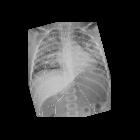Near drowning pulmonary edema

Preschooler
found face down in a swimming pool. CXR AP shows a normal sized heart and bilateral perihilar interstitial infiltrates. There is also a dense opacity in the right upper lobe.The diagnosis was pulmonary edema due to near drowning and probable aspiration pneumonia of the right upper lobe.

Near drowning
pulmonary edema • Near drowning pulmonary edema - Ganzer Fall bei Radiopaedia

Near drowning
pulmonary edema • Near drowning (pulmonary edema) - Ganzer Fall bei Radiopaedia

Near drowning
pulmonary edema • Near-drowning pulmonary edema - Ganzer Fall bei Radiopaedia

Preschooler
after an episode of near drowning. CXR AP shows bilateral perihilar infiltrates in a butterfly wing distribution.The diagnosis was non-cardiogenic pulmonary edema due to near drowning.

Near drowning
pulmonary edema • Near-drowning pulmonary edema - Ganzer Fall bei Radiopaedia
Near drowning pulmonary edema is considered an etiological subtype of non cardiogenic pulmonary edema. It can occur with both salt water and fresh water near-drowning.
Pathology
It is thought to result from the inhalation of either fresh water or sea water resulting in lung damage and a ventilation-perfusion mismatch.
Near drowning can be divided into three stages:
- stage 1: acute laryngospasm that occurs after inhalation of a small amount of water
- stage 2: the victim still usually presents with laryngospasm but may begin to swallow water into the stomach
- stage 3
- 10-15% of patients still present with dry drowning caused by persistence of the associated laryngospasm
- in the remaining 85-90% of patients, the laryngospasm relaxes secondary to hypoxia and large amounts of water are aspirated
Radiographic features
Radiography
Features in stages 2 and 3 on chest radiographs are usually identical to pulmonary edema from other non-cardiac causes .
Siehe auch:

 Assoziationen und Differentialdiagnosen zu Lungenödem bei Beinahe-Ertrinken:
Assoziationen und Differentialdiagnosen zu Lungenödem bei Beinahe-Ertrinken:
